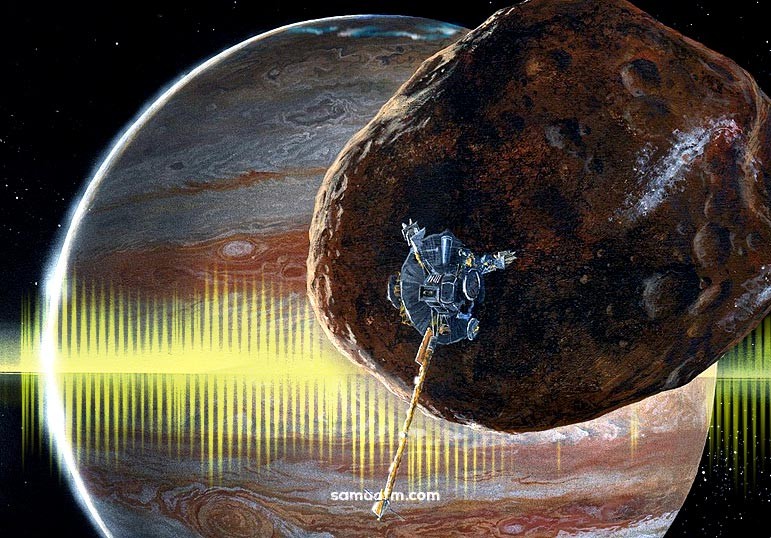
FM Radio Signal Found Coming from Jupiter Moon Ganymede
New discoveries emerged as the Juno spacecraft orbiting Jupiter has discovered an FM radio signal coming from the moon of planet Jupiter Ganymede. The find is a first-time detection from the moon itself. According to the NASA’s Ambassadors to Utah Patrick Wiggins, he said that, “It’s not E.T.,” “It’s more of a natural function.”
Ganymede
Ganymede’s discovery is credited to Galileo Galilei, the first to observe it, on January 7, 1610. It is the largest moon in the solar system. It is composed of half water ice and half rock. This satellite of Jupiter is unique for its long, curved grooves in the crust that make it unlike any other planetary body ever seen. Areas of dark and light terrain with differing densities of impact craters suggest that the moon has gone through several periods of crust formation.
Ganymede has a diameter of 5,268 km (3,273 mi), making it 26% larger than the planet Mercury by volume, although it is only 45% as massive. It possesses a metallic core and has the lowest moment of inertia factor of any solid body in the Solar System and is the only moon known to have a magnetic field. Outward from Jupiter, it is the seventh satellite and the third of the Galilean moons, the first group of objects discovered orbiting another planet. Ganymede orbits Jupiter in roughly seven days and is in a 1:2:4 orbital resonance with the moons Europa and Io, respectively.
The moon is made out of roughly equivalent measures of silicate rock and water. It is a completely separated body with an iron-rich, fluid center, and an inner sea that may contain more water than the entirety of Earth’s seas consolidated. Its surface is made out of two primary kinds of territory. Dull areas, immersed with sway cavities and dated to four billion years back, cover about 33% of it. Lighter areas, crosscut by broad scores and edges and just somewhat less old, cover the rest of. The reason for the light landscape’s disturbed geography isn’t completely known; however was likely the after-effect of structural action because of tidal warming. Ganymede’s magnetic field is most likely made by convection inside its fluid iron center. The small attractive field is covered inside Jupiter’s a lot bigger attractive field and would show just as a local preturbation of the field lines. Ganymede has a meager oxygen air that incorporates O, O2, and conceivably O3 (ozone). Nuclear hydrogen is a minor air constituent. Regardless of whether Ganymede has an ionosphere related with its climate is uncertain.
The Signals Received From Jupiter Ganymede
Juno was traveling across the polar region of Jupiter — where magnetic field lines connect to Ganymede — when it crossed the radio source. Scientifically, it is called a “decametric radio emission.” Here on Earth, we know it as Wi-Fi, and we use it every day.
According to Britannica.com, the radio emissions of Jupiter were first discovered in 1955, and over the last 66 years, more and more discoveries have been made about how the signals work. “A member of the Salt Lake Astronomical society once built an amateur radio telescope that could detect the electromagnetic radiation from Jupiter,” Wiggins said.

Juno Spacecraft Probe around Jupiter Moon Ganymede
Juno is a NASA space probe circling the earth. Juno’s central goal is to quantify Jupiter’s composition, gravitational field, magnetic field, and polar magnetosphere. It will also look for pieces of information about how the planet formed, including whether it has a rough center, the measure of water present inside the profound climate, mass dispersion, and its deep winds, which can arrive at speeds up to 620 km/h (390 mph). Juno is the second shuttle to circle Jupiter, after the nuclear-controlled Galileo orbiter, which circled from 1995 to 2003. Dissimilar to all previous spacecraft shipped off the external planets, Juno is fueled by solar arrays, normally utilized by satellites circling Earth and working in the internal Solar System, while radioisotope thermoelectric generators are usually utilized for missions to the external Solar System and past. For Juno, be that as it may, the three biggest sun-oriented cluster wings ever conveyed on a planetary probe assume a vital job in settling the shuttle just as generating power.

Juno’s mission is to study how the planet Jupiter formed and how it evolved. “Juno will observe Jupiter’s gravity, and magnetic fields, atmospheric dynamics and composition, and evolution,” according to NASA.
What caused the radio emissions from Jupiter’s moon? Electrons, not aliens, caused the signals. The electrons oscillate at a lower rate than they spin, making the electrons intensify radio waves quickly. The cycle is called cyclotron maser instability (CMI). The electrons that produce the radio sign can likewise cause auroras in the far-bright range, a wonder additionally saw by the camera on Juno.
The spacecraft saw the moon’s radio emission for only five seconds. It was flying by at 50 km per second — a screaming 111,847 mph.
READ MORE: COSMIC PHENOMENON: JUPITER AND SATURN TO ALIGN TONIGHT AFTER 800 YEARS!




